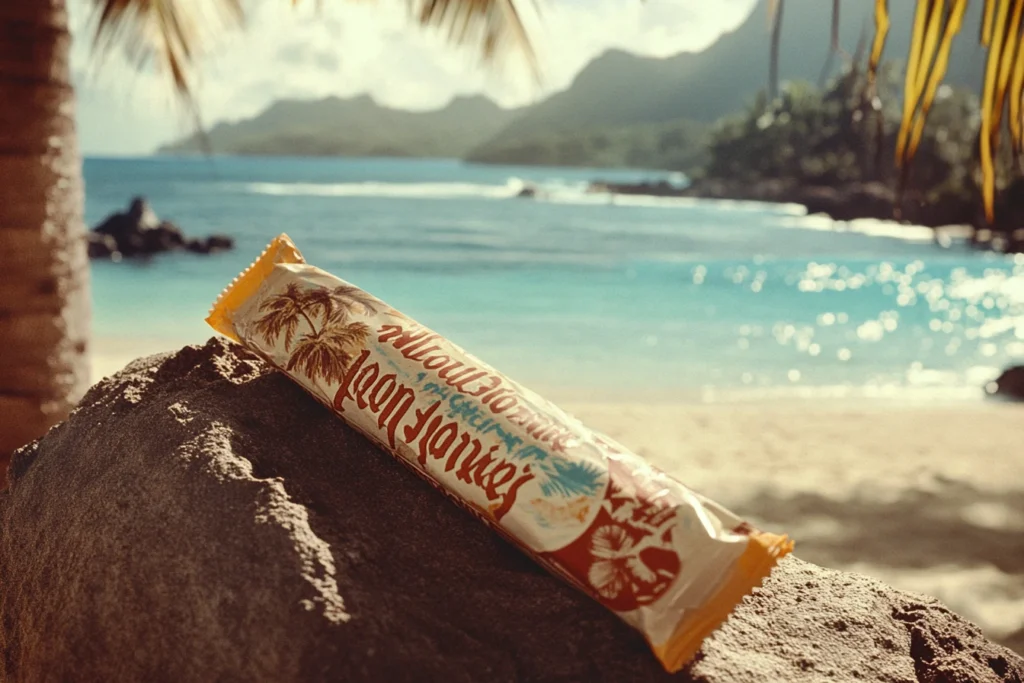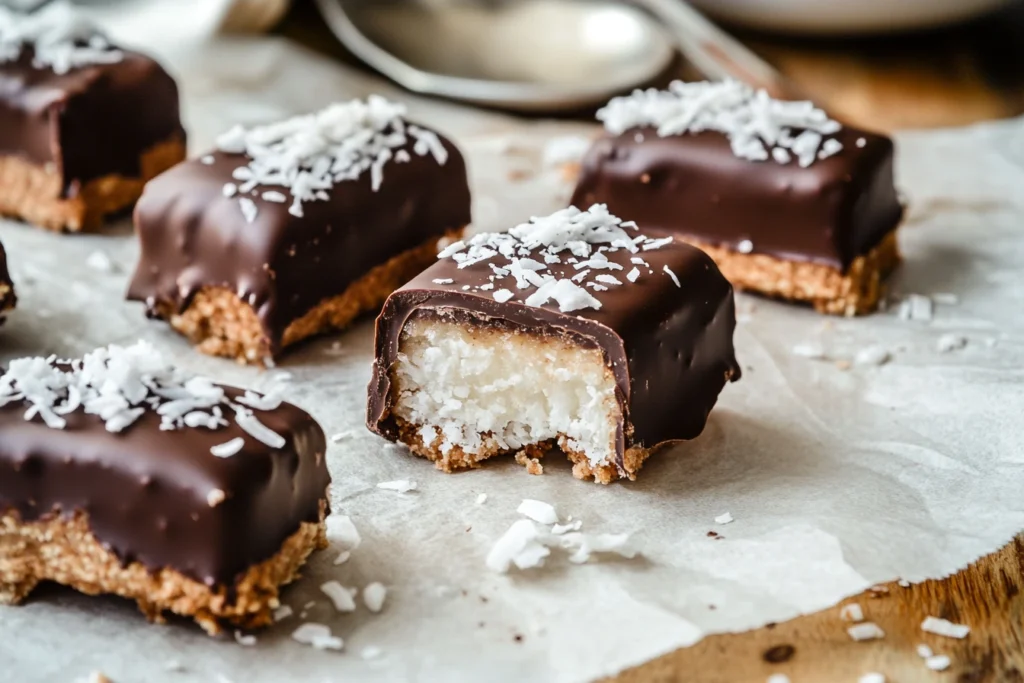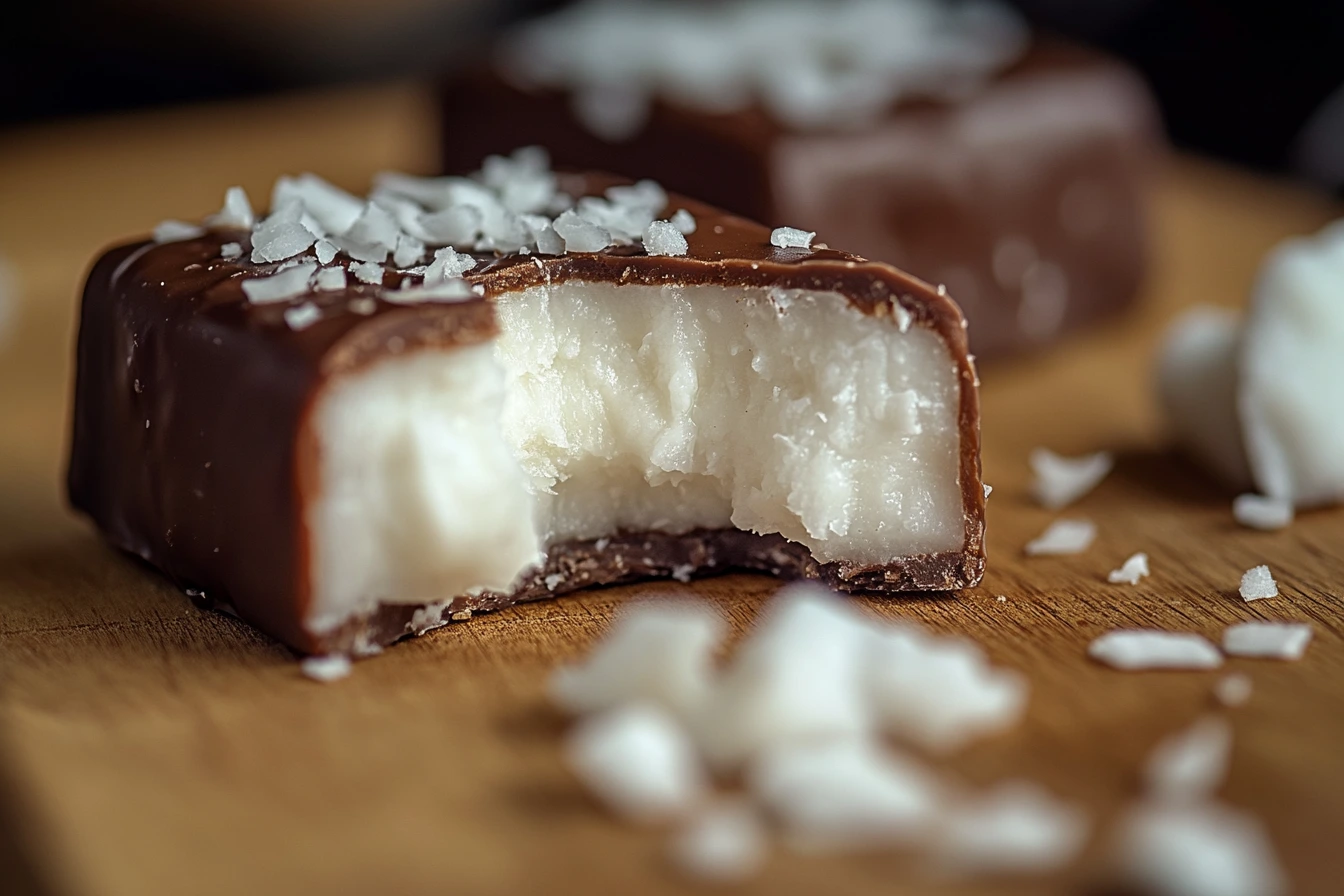There are few candy bars in the world that spark nostalgia quite like the Bounty chocolate bar. With its lush, moist coconut filling wrapped in a smooth layer of milk or dark chocolate, this tropical-inspired treat has carved a special place in the hearts of coconut lovers everywhere.
Whether you remember enjoying a Bounty candy bar on a road trip, pulling one from your Halloween stash, or sneaking one from the corner shop as a kid, there’s something irresistibly comforting about this classic confection.
Today, we’re diving into everything Bounty—from its history and cultural quirks to a delectable homemade recipe you’ll want to make on repeat.
A Sweet Slice of History: Where Did Bounty Bars Come From?

The Bounty bar was first introduced by Mars, Incorporated in 1951, in the United Kingdom and Canada. Inspired by the success of the American Mounds bar (made by Hershey), Mars decided to create their own version, tweaking the recipe to suit European tastes.
The result? A delicious bar that soon became a mainstay across the globe, especially in Europe, Australia, and Asia.
Interestingly, the Bounty chocolate bar is not sold in the United States under the Bounty brand. Instead, the closest equivalents are the Mounds (dark chocolate, no milk version) or Almond Joy (which adds almonds to the mix).
What Makes a Bounty Bar So Irresistible?
At first glance, the ingredients of a Bounty bar sound simple:
- Moist shredded coconut
- Sugar and glucose syrup
- A layer of milk chocolate (or dark chocolate, for the blue-wrapper fans)
But the magic is in the texture. Bounty’s coconut filling is famously soft and juicy—not dry or overly chewy. It balances sweet and rich without being overpowering. And that smooth chocolate coating? Just the right amount to complement the filling without masking it.
Love It or Hate It: The Great Bounty Debate
One reason the Bounty bar remains such a cultural icon is that it’s also surprisingly polarizing.
In the UK, surveys have shown Bounty often ranks as one of the most disliked sweets in the classic Celebrations chocolate box. In fact, Mars even ran a “No Bounty in Celebrations” trial in 2022 after public feedback.
But for coconut lovers? The Bounty candy bar is sacred.
There’s something unapologetically retro about it—a taste of simpler times, perhaps. A time when coconut and chocolate were the ultimate indulgence.
How to Make Bounty Bars at Home (That Taste Better Than the Original)
Craving a homemade Bounty bar that’s fresher, less sugary, and just as dreamy? This simple recipe captures all the tropical goodness with only a few ingredients.

Ingredients (Makes ~10 small bars)
- 2 cups unsweetened shredded coconut
- ½ cup condensed milk
- 2 tbsp coconut cream (optional, for extra richness)
- 1 tsp vanilla extract
- 200g (7 oz) dark or milk chocolate, melted
- Pinch of salt
Prep Time: 10 minutes
Chill Time: 1 hour
Total Time: 1 hour 10 minutes
Instructions
Step 1: Mix the Coconut Filling
In a large mixing bowl, combine the shredded coconut, condensed milk, vanilla extract, and a pinch of salt. Add the coconut cream for a richer texture (optional but delicious). Mix until the coconut is well-coated and forms a sticky mass.
Step 2: Shape the Bars
Using clean hands or a mold, shape the mixture into small bars—roughly the size of a store-bought Bounty candy bar. Place them on a parchment-lined tray.
Step 3: Chill
Pop the tray into the freezer for at least 45 minutes to 1 hour. This firms up the bars and makes them easier to coat in chocolate.
Step 4: Melt the Chocolate
Break your chocolate into small pieces and melt it in a heatproof bowl over simmering water (double boiler method) or microwave in 30-second bursts.
Step 5: Dip and Set
Using a fork or dipping tool, lower each coconut bar into the melted chocolate, making sure it’s fully coated. Let the excess chocolate drip off, then place it back onto the parchment paper.
Let them set at room temperature or chill in the fridge for faster results.
Tips for Perfection
- Add a drop of almond extract for an Almond Joy-style twist.
- Prefer dark chocolate? Use 70% cacao for a less sweet version.
- Sprinkle sea salt or drizzle with white chocolate for a gourmet finish.
Fun Facts About Bounty Chocolate Bars
- The red-wrapped Bounty is milk chocolate, while the blue-wrapped version is dark chocolate.
- In Australia and New Zealand, Bounty bars are often found in mini-sized snack packs.
- Bounty used to have an advertising campaign featuring tropical beaches, reinforcing its “paradise” vibe.
- It’s one of the few candy bars where coconut is the hero—not just a background flavor.
Are Bounty Bars Vegan or Gluten-Free?
Most commercial Bounty bars are not vegan, as they contain dairy in the chocolate and condensed milk. However, homemade Bounty bars are easily adapted by using:
- Dairy-free condensed coconut milk
- Vegan chocolate
- Gluten-free certification (they’re typically gluten-free by ingredient, but cross-contamination matters)
Where Can You Buy Bounty Bars?
While not available in the U.S. under the Bounty name, they are widely stocked in:
- UK and EU supermarkets (Tesco, Sainsbury’s, Lidl)
- Asian markets and international sections
- Amazon and online specialty stores
- Duty-free shops and international airports
They often appear in Celebrations tubs, alongside other Mars confections like Snickers, Milky Way, and Galaxy.
FAQs About Bounty Candy Bars
❓Is the Bounty candy bar healthy?
Not exactly—it’s still a candy bar with sugar and chocolate. However, the high coconut content provides a bit of fiber and healthy fat. Homemade versions can be much healthier with natural sweeteners.
❓What’s the difference between Bounty and Mounds?
Mounds is the U.S. equivalent made by Hershey. It uses dark chocolate only, while Bounty offers both dark and milk chocolate varieties. The taste and texture of the coconut also differ slightly.
❓Why do people dislike Bounty bars?
Coconut has a unique texture and strong flavor. People either love it or loathe it. In taste tests, Bounty is often ranked last—but coconut fans swear it’s the best of the bunch.
❓Can I freeze Bounty bars?
Yes! Homemade and store-bought Bounty bars freeze beautifully. Just wrap them tightly and store in a freezer-safe container. They’ll keep for up to 3 months.
❓Are there other flavors of Bounty?
Yes! Over the years, Mars has released limited-edition versions like Cherry Bounty, Mango, and even Bounty Ice Cream bars. These are harder to find but worth hunting for.
Final Thoughts: A Tropical Classic Worth Rediscovering
The Bounty Bars might be one of the most debated treats out there, but love it or hate it, its tropical charm is hard to ignore. From its lush coconut center to the smooth chocolate shell, it offers a flavor journey that’s both nostalgic and uniquely satisfying.
And if you’re craving something savory after all that sweetness, check out our creamy and spicy Buffalo Chicken Pasta Bake—a perfect contrast to the tropical vibes of Bounty Bars.
Whether you’re enjoying the store-bought version or making them from scratch at home, Bounty Bars are a candy that continues to spark conversation and cravings across the globe.
Print
Bounty Bars: The Iconic Tropical Chocolate
- Total Time: 45 minutes
- Yield: 12 bars
- Diet: Gluten Free
Description
Indulge in these homemade Bounty Bars featuring a rich, moist coconut filling encased in a smooth chocolate shell. This healthier version uses natural ingredients, offering a delightful treat without refined sugars.
Ingredients
Coconut Filling:
2 cups unsweetened shredded coconut
½ cup coconut cream
¼ cup maple syrup or preferred liquid sweetener
1 teaspoon vanilla extract
Pinch of sea salt
Chocolate Coating:
1 cup dark chocolate chips or chopped dark chocolate (70% cocoa or higher)
1 tablespoon coconut oil
Instructions
Prepare the Coconut Mixture:
In a mixing bowl, combine shredded coconut, coconut cream, maple syrup, vanilla extract, and a pinch of sea salt. Mix until the ingredients are thoroughly combined and the mixture holds together when pressed.
Shape the Bars:
Using your hands, form the coconut mixture into small rectangular bars, resembling the traditional Bounty Bar shape. Place them on a baking sheet lined with parchment paper.
Chill the Bars:
Transfer the baking sheet to the freezer and let the bars chill for about 20-30 minutes, or until they are firm.
Melt the Chocolate:
While the bars are chilling, melt the dark chocolate and coconut oil together using a double boiler or in the microwave in short intervals, stirring until smooth.
Coat the Bars:
Remove the firm coconut bars from the freezer. Using a fork, dip each bar into the melted chocolate, ensuring it is fully coated. Allow excess chocolate to drip off before placing the bar back onto the parchment-lined baking sheet.
Set the Chocolate:
Once all bars are coated, place the baking sheet in the refrigerator for about 10-15 minutes, or until the chocolate has fully set.
Notes
For an extra thick chocolate coating, repeat the dipping process after the first layer has set.
Store the bars in an airtight container in the refrigerator for up to a week.
To make the recipe vegan, ensure that the dark chocolate used is dairy-free
- Prep Time: 15 minutes
- Cook Time: 30 minutes
- Category: Dessert
- Method: No-Bake
- Cuisine: International
Nutrition
- Serving Size: 1 bar
- Calories: 210 kcal
- Sugar: 8g
- Sodium: 15mg
- Fat: 16g
- Saturated Fat: 12g
- Unsaturated Fat: 3g
- Trans Fat: 0g
- Carbohydrates: 16g
- Fiber: 4g
- Protein: 2g
- Cholesterol: 0mg

